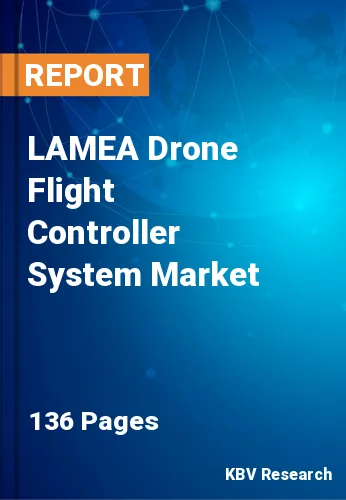The Latin America, Middle East and Africa Drone Flight Controller System Market would witness market growth of 10.8% CAGR during the forecast period (2023-2030).
The drone flight controller is a component in an unmanned aerial vehicle (UAV) or drone used for managing and controlling its flight. The drone's central processing unit (CPU) is responsible for supervising and controlling various facets of its operation to ensure a flight that is both stable and under control. Drone flight controller systems consist of sensor-integrated circuit boards capable of detecting the drone's motion and reacting to commands issued by the user. By acting as a central gateway, they facilitate the connection of numerous drone peripherals, including ESC, GPS, LED, servos, radio receivers, FPV cameras, and VTX. Moreover, these flight controllers can stabilize the drone automatically, hover in a fixed position (loitering), and enable autonomous flight. The significance of these components resides in the critical function they perform while piloting drones, rendering them an essential element in the fabrication of any drone.
Drones equipped with specialized flight controller systems have revolutionized agriculture practices. Precision agriculture, facilitated by drones, allows for the efficient monitoring and management of crops. Flight controllers enable drones to execute predefined routes, capture high-resolution images, and analyze data for crop health assessment, pest detection, and irrigation management. In the construction industry, drone flight controller systems are pivotal in surveying and mapping large areas quickly and accurately. These systems enable drones to navigate construction sites, capture aerial footage for project documentation, and monitor progress. The real-time data acquisition capabilities contribute to enhanced project management and decision-making.
The oil and gas sector in the Middle East, in particular, has shown interest in drone technology for pipeline inspection, monitoring infrastructure, and enhancing safety measures. Flight controller systems ensure precise and controlled drone operations in these applications. Initiatives focused on training and capacity building for drone operators contribute to the responsible and widespread adoption of drone technology. As a result, these aspects will boost the market growth in the coming years.
The Brazil market dominated the LAMEA Drone Flight Controller System Market by Country in 2022, and would continue to be a dominant market till 2030; thereby, achieving a market value of $210.9 Million by 2030. The Argentina market is showcasing a CAGR of 11.9% during (2023 - 2030). Additionally, The UAE market would register a CAGR of 10.4% during (2023 - 2030).
Free Valuable Insights: The Worldwide Drone Flight Controller System Market is Projected to reach USD 10.2 Billion by 2030, at a CAGR of 7.8%
Based on Application, the market is segmented into Rotary Wing Drone, and Fixed-Wing Drone. Based on End-Use, the market is segmented into Commercial Aviation, Military Aviation, and Others. Based on Sales Channel, the market is segmented into Offline, and Online. Based on Range of Operation, the market is segmented into Short Range, Mid Range, and Long Range. Based on countries, the market is segmented into Brazil, Argentina, UAE, Saudi Arabia, South Africa, Nigeria, and Rest of LAMEA.
By Application
By End-Use
By Sales Channel
By Range of Operation
By Country
Our team of dedicated experts can provide you with attractive expansion opportunities for your business.

